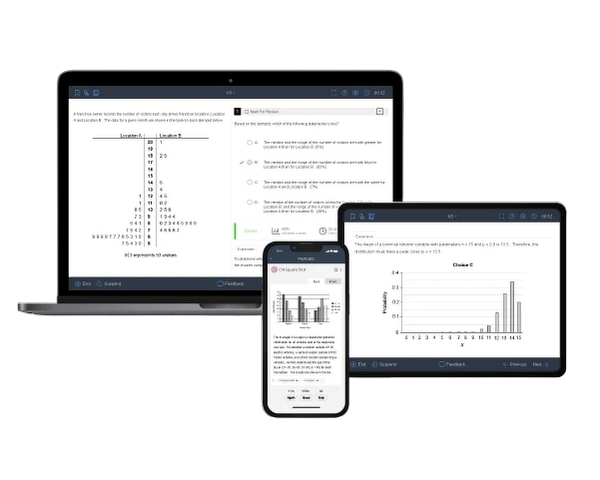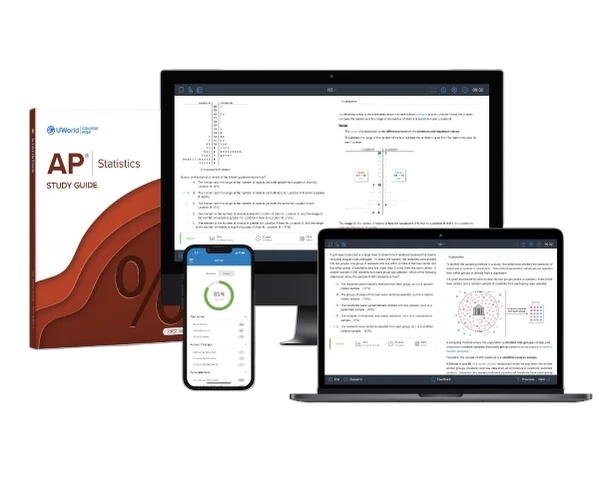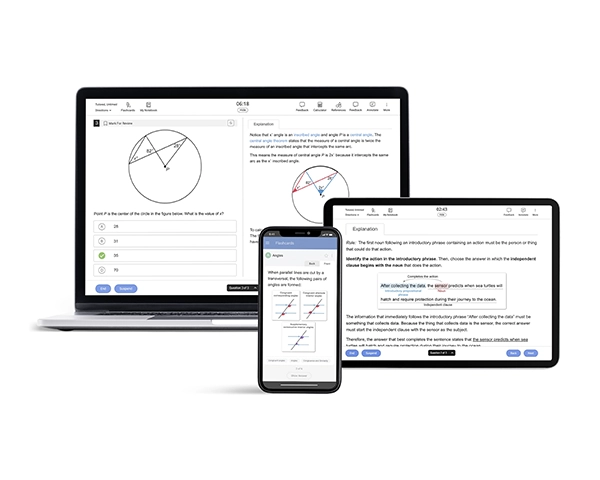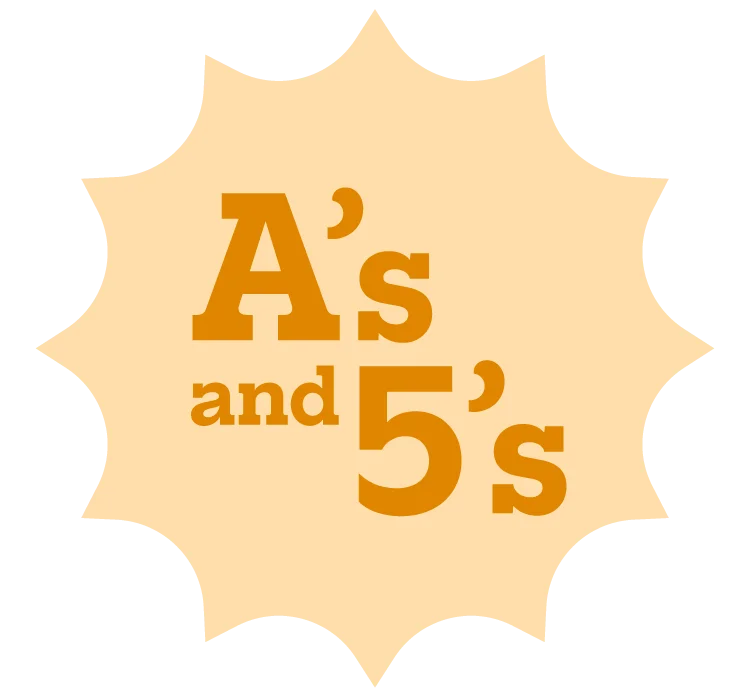This step-by-step guide is here to help you learn problem-solving strategies and analytical and writing skills to make your preparation hassle-free. We'll help you prepare a study schedule tailored to your requirements so you can study smarter for your upcoming AP® Statistics exam.
How to Study for AP Statistics Exam
The AP Statistics course is comparable to a 1-semester, non-calculus-based college course in introductory statistics. From the moment you sign up for an AP Statistics class to exam day, you can take the following steps to prepare and improve your chances of getting the score you want.
How to Prepare for the AP Statistics
If you prepare beforehand, each course unit will be easier and quicker to learn. Here are some things you can do before the school year starts.
- Make sure you can meet the prerequisites for the course
- Completion of a second-year course in algebra
You get bonus points for geometry and precalculus, although calculus is not required for the exam.
Once you meet those prerequisites, here are some things you can do to prepare during the summer before taking the course.
- Familiarize yourself with College Board's® AP Statistics course exam and description.
- Talk with teachers and other advisors. Your statistics teacher can tell you about the expectations of the class. Your guidance counselor may also be able to tell you about the rigor of the course.
- Brush up on algebra concepts. Specifically, focus on algebraic manipulations, linear equations, inequalities, graphs, functions, exponential functions, logarithms, and probability.
- Identify learning materials that work well with your learning strategies and lifestyle. These can be textbooks (online and paper), study guides, videos, apps, practice problems, etc.
- Study Unit 1 concepts and practice some AP Statistics questions for that unit. Most of the material should be a review of the algebra and other math courses you have taken.
How to Pass a Statistics Class
AP Statistics is focused on four main concepts:
- Exploring data (Units 1-2 )
- Sampling and experimentation (Unit 3)
- Probability and Simulation (Units 4-5)
- Statistical Inference (Units 6-9)
Here are some tips for passing an AP Statistics class:
- Practice and review every day. At least 30 minutes a day is recommended. Plan your study hours with an efficient and structured schedule.
- Flashcards are an efficient tool to learn and memorize AP Statistics basic terms and concepts.
- Practicing multiple-choice questions is perhaps the most efficient way to study AP Statistics. Get that practice with the multiple-choice questions in our question bank.
- Practice free-response questions from tests from past years because they can be repetitive from year to year. Analyze the scoring guidelines to understand expectations.
- Always set aside some time to revisit previous units. Occasional review of materials effectively prevents your knowledge from becoming rusty.
- Ask the teacher for help and suggestions on how to improve. They will be happy to assist you and may be able to identify specific growth areas.
How to Do Well on the AP Statistics Exam
While every class is different and it depends on circumstances, doing well in your AP Statistics exam and following the steps gives a solid foundation for achieving a 3 on the exam. In 2024, 61.8% of students achieved a score of 3 or greater on the exam.
But if you are confident you can master the basics and want to shoot for a 4 or 5, you will need more time preparing and need to be efficient in how you study. Unit 1 represents the most significant weight on the exam (15-23% of the exam). Still, Units 4, 6, and 7 should also be your focus because they also represent a large proportion of the exam content.
Improving your score from 3 to 4 requires you to improve from being “Qualified” to “Well Qualified”. Here are some AP Statistics exam tips to improve your score from 3 to 4. In addition to the steps above:
- Increase practice time to 45 minutes every day.
- Review your notes every day for that day and the previous day's class.
- Around spring break, create a study plan for reviewing the course content.
- Increase the number of AP Statistics multiple-choice questions (MCQs) you practice every day.
- Increase practice of free-response questions (FRQs) with AP Classroom and the ones College Board provides. Keep an eye out for commonly asked questions and emphasize them.
- One month before the exam, increase study time to 1.5 hours a day.
- Ask the teacher for help and suggestions on how to improve. They will be happy to assist you and may even identify specific growth areas.
How to Score a 5 on the AP Statistics Exam
Achieving a top score of 5 on the AP Statistics exam doesn't require perfection. In 2024, 17.5% of the 252,914 test-takers earned a score of 5, while 61.8% scored 3 or higher. Notably, a score of 5 doesn't equate to answering 90% of the questions correctly, as might be expected for an “A” in typical U.S. grading systems. Instead, focus on maximizing points in areas you're confident in. For more challenging questions, eliminate incorrect answers and make educated guesses to optimize your score.
Knowing where to spend your study time is vital. For example, understanding that the formulas on the exam are mostly derived from one of several general formulas (e.g. general test statistic formula). One MCQ is not worth a lot, so if you are struggling to remember the formula, practice a few of our questions and make a flashcard with the formula to quiz yourself occasionally, but do not spend too much time on it. You will get more out of focusing on more critical concepts.
Here are some AP Statistics study tips to help you earn that coveted 5, in addition to the steps to earn a minimum of 3:
- Be prepared to practice for 45 to 60 minutes every day.
- Increase the number of AP Statistics multiple-choice questions you practice every day.
- Practice more FRQs, emphasizing frequently tested questions.
- Keep track of concepts you have trouble with. Consider asking your teacher for extra clarification on those topics, and practice more problems in those areas.
By spring break:
- Increase study time to 1.5 to 2 hours per day.
- Time yourself on FRQs based on the timing of each section on the exam. If you find yourself running out of time, identify the concepts and question types that take you the longest.
Which Units are the Most Challenging?
According to past students4 who took the exam, the most challenging units on the exam are Unit 4 (Probability, Random Variables, and Probability Distributions) and Unit 5 (Sampling Distributions), both of which focus on the concept of probability. These units represent a large portion of the questions on the AP Statistics exam.
In general, probability is a difficult topic for students to understand. Luckily, repeated practice does wonders for doing well with questions involving probability. Memorization of specific factors or formulas is less important for probability problems. There are often several ways to solve a given probability problem, and once you find the strategies that work best for you, you can apply them in novel situations.
There are particular types of probability problems that we have identified as being particularly important to study because they show up often and are often missed by students.
For Unit 4:
- Calculating probabilities for independent events and for the union of two events
- Calculating probabilities for binomial and geometric variables
- Calculating parameters (mean, standard deviation) for linear transformations
- Calculating parameters (mean, standard deviation) for linear combinations
For Unit 5, students tend to perform poorly on questions that require interpreting the calculations rather than the formulas themselves.

How to Self-Study for the AP Statistics Exam
If you plan to self-study for the AP Statistics exam without taking an AP course, you may have a few more obstacles and challenges ahead. However, it is definitely doable. The biggest challenge will be not having a teacher introduce concepts and help you improve. So your first step is to find out what learning style works best for you.
Do you learn well from practicing questions, watching videos, or reading a textbook? Most students learn from a combination of these approaches, so try different things and see what works best for you. Our recommendation would be to incorporate all of them.
Here's a general flow you can use to facilitate your learning process:
- Watch a video on a topic and take notes.
- Rewatch the video if the topic still isn't clear, or watch a similar video from another source. Sometimes, hearing or seeing a concept presented in multiple ways can help clear up confusion.
- Read a textual explanation of the topic and add it to your notes.
- Work practice problems on the topic. Use the UWorld AP Statistics Practice Question Bank, read through our explanations, especially on questions you answer incorrectly. We also include hyperlinks to general explanations of concepts or alternate/more detailed solutions, so we encourage you to explore those as well.
- Review your notes at the end of your study session.
This flow may or may not work for you. Experiment and figure out what elements to incorporate into your study plan. See the next section for tips on creating a study plan that is right for you.
AP Statistics Exam Tips & Study Schedule
Now it is spring break (or later), and it is time for the full-court press. No matter your time frame, we have a customized study schedule and AP Statistics exam tips for you to stay on track and prepare for the exam.
Best-case scenario, you should start buckling down around spring break. Take a few days or a week off to relax if the rigor of an AP schedule has stressed you out. Not getting overwhelmed is very important for succeeding in the exam. Now let's get started! Spend some time reviewing individual units over the first month or two before the exam. Work your way through the course material, starting with Unit 1. Review your notes, solve some practice questions on each topic, and make a note of any areas where you are having difficulty. Here is a schedule that we have developed that takes into account how long it takes to study each Unit and how important each one is for the overall exam.
| Week 1 | Study Unit 1 Every Day
|
| Week 2 | Study Units 2 and 3 Every Day
|
| Week 3 | Study Units 4 and 5 Every Day
|
| Week 4 | Study Unit 6 Every Day
|
| Week 5 | Study Units 7,8, and 9 Every Day
|
| Weeks 6-9 | Mix Units Every Day
|
| Every Day of the Week |
|
| End of the Week |
|
Another thing to consider in your study schedule is your other AP courses if you have any. Make sure your schedule factors in time for all of them. For example, if you are taking 4 AP classes this year, commit 30 minutes on weeknights and 2 hours on weekends to each.
A structured AP Statistics study guide can help you stay organized and ensure you're covering key topics efficiently. Find a schedule that allows you to spend enough time on each subject, and make sure you factor in your other AP exam dates into your study schedule to prioritize accordingly. Similarly, planning ahead is key in setting your schedule around extracurricular activities and sports.
Finally, structure breaks into your study schedule. You may not have time to take a day off, but you will learn and absorb information much better if you are well-rested. Take some time away from the material periodically to do something fun or completely unrelated. Either set a regular day in the week when you do not study or learn to recognize when you are feeling burned out and take the afternoon off.
If you only have 1 month until the exam, you still have enough time to prepare. Like the 2-month schedule, you will want to start with a general review of the course topics, unit by unit, but at a much quicker pace. Use your textbook and class notes if you need refreshers on the concepts, but spend most of your time completing your textbook practice problems or the UWorld QBank.
| Week 1 | Study Units 1, 2, 3, and 4 Every Day
|
| Week 2 | Study Units 5, 6, 7, 8, and 9 Every Day
|
| Weeks 3-4 | Mix Units Every Day
|
| Every Day of the Week |
|
| End of the Week |
|
With a 2-week schedule, time is much more limited. For the first week, practice a few UWorld MCQs in each topic to find problem areas, read through the answer explanations, and review your class notes in those areas. If necessary, find a video or read your textbook on a topic if it is not sticking. After reviewing the problem area, try some more UWorld questions to see how you have improved.
For the second week, spend most of your time practicing FRQs. FRQs hit many topics simultaneously, so they are a very time-efficient way to practice the course material. They also often require you to show your steps, so they are a great way to emphasize the entire process of answering questions.
| Week 1 | Multiple Choice Questions Every Day
|
| Week 2 | Free Response Questions Every Day
|
| Every Day of the Week |
|
| End of the Week |
|
AP Statistics Review/Study Materials
Finally, here is a collection of materials you can use to facilitate your study. Most of these links are sprinkled throughout this guide, but we've listed them in one section for your convenience.
Quality Prep Courses: Use UWorld's AP Statistics prep course, which comes with a comprehensive study guide and an extensive question bank to help students achieve their desired scores. UWorld also offers digital study tools such as flashcards, notebooks, a built-in timer, a calculator, and a progress tracker to help students maximize their retention of concepts and keep their performance in check.
Question Banks and Practice Problems:
- UWorld: AP-level MCQs with detailed explanations that help you learn from your mistakes and reinforce key concepts.
- Princeton Review's Cracking the AP Statistics Exam: Offers strategies, practice tests, and targeted review sections.
- AP Classroom: Official College Board platform that includes past AP test questions but requires a teacher to assign them.
- College Board FRQs: A collection of free-response questions from past exams, providing excellent practice for the written portion.
Video Content
- Stats Medic: Engaging video lessons and resources designed specifically for AP Statistics students.
- Mr. Nystrom's AP Stats Channel: A great resource for concept explanations, problem walkthroughs, and exam tips.
Now that you've learned how to study for AP Statistics, it's time to practice. Passing the AP Statistics exam requires dedication and hard work. With the right study materials and an effective study schedule, it is possible to achieve your goal. Good luck!

References
- (2020). Course Content. AP® Statistics Course and Exam Description. College Board. Retrieved on February 14, 2025, from https://apcentral.collegeboard.org/media/pdf/ap-statistics-course-and-exam-description.pdf.
- (2024). Past AP Statistics Score Distributions. AP Students. College Board. Retrieved on February 14, 2025, from https://apstudents.collegeboard.org/about-ap-scores/score-distributions.
- (2024). AP® Statistics Scoring Statistics 2024 Free-Response Questions. AP. College Board. Retrieved on February 14, 2025, from https://apcentral.collegeboard.org/media/pdf/ap24-statistics-scoring-statistics.pdf
Read More Links
FRQs can trouble you if you don't know the right strategy. See our comprehensive hands-on article for approaching each question type in the free-response section effectively.
How to Approach AP Statistics MCQsAnswering MCQs appears simple, but the correct answer can differ by a small margin. Learn from our well-resourced hands-on manual to ace the multiple-choice section with ease.
About AP Statistics ExamWondering if AP Statistics is right for you? We've got you covered with our exam guide, which clearly explains what's on the exam, why to take it, prerequisites, difficulty, and more!
Best AP Statistics Study Guide ComparisonExplore top AP Statistics study guides to find the best resources for the exam. Compare features, pros, cons and reviews to select the perfect guide for success.
Best AP Statistics Prep Course ReviewDiscover the best AP Statistics prep courses available. Compare key features, pricings, reviews, and benefits to select the course that best fits your learning.
How to Self-Study for AP StatisticsLearn effective tips and strategies to self-study for the AP Statistics exam. Build confidence, master core concepts, and achieve a high score independently too.




